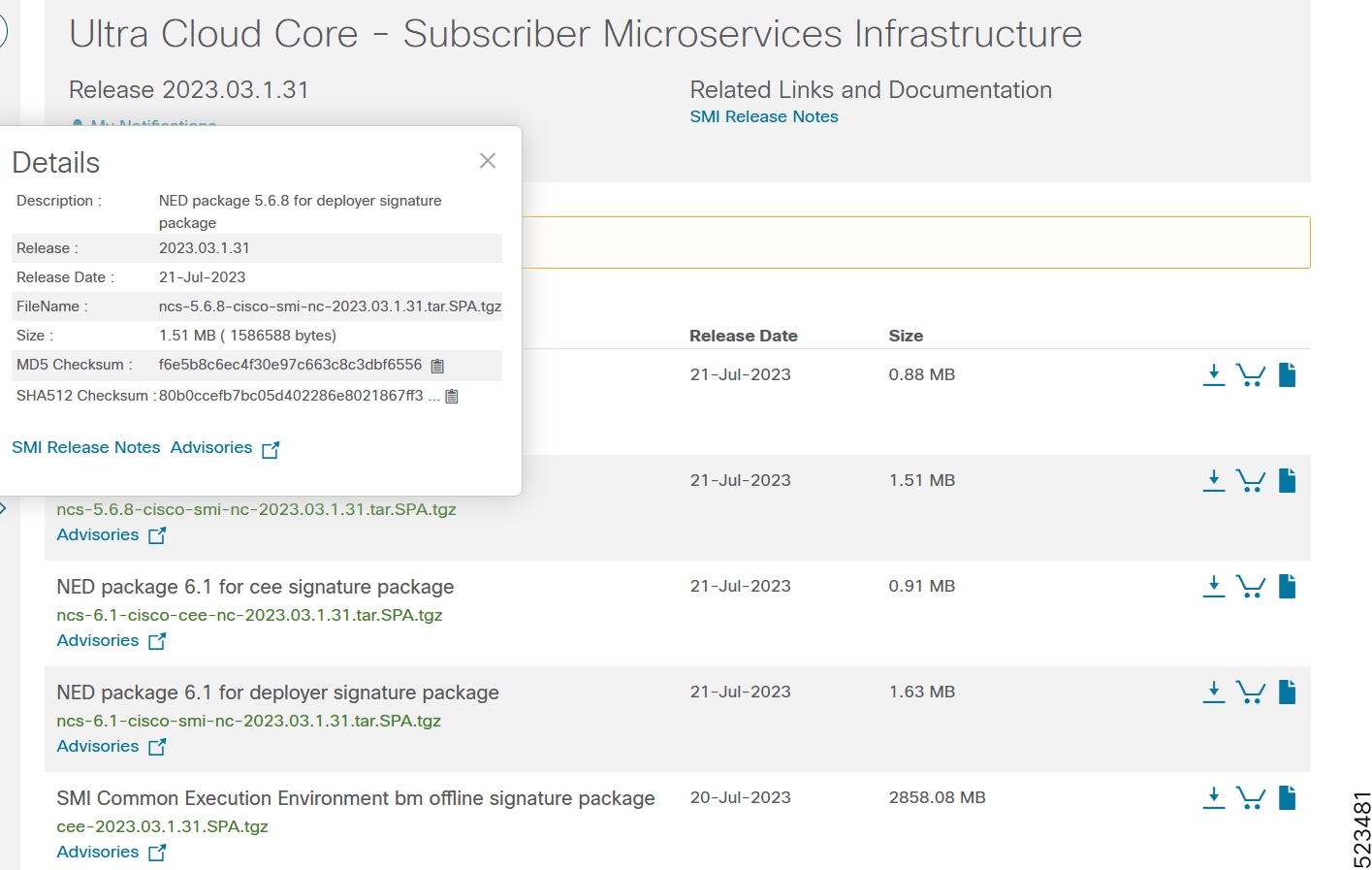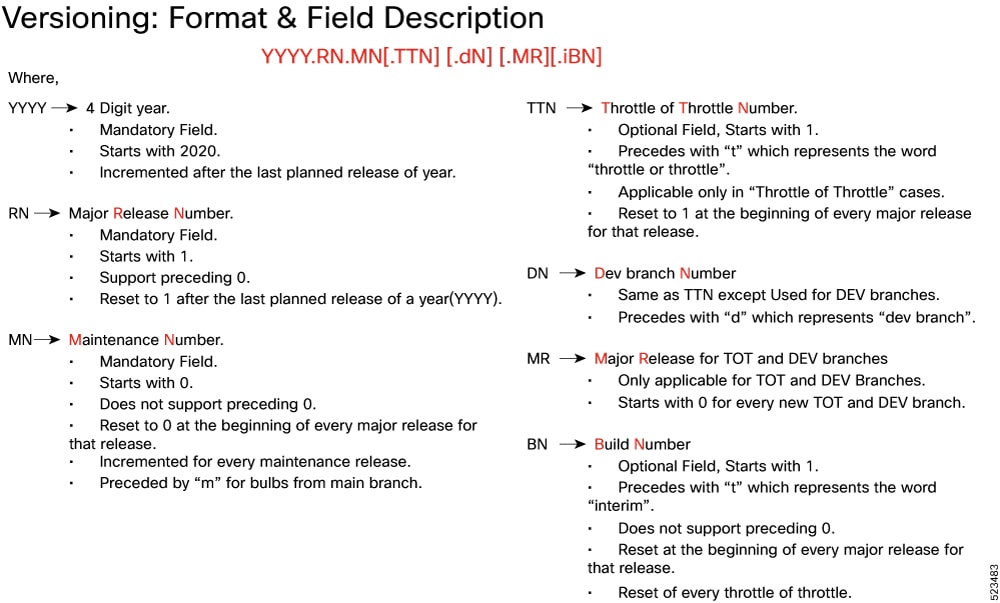Ultra Cloud Clore Subscriber Management Infrastructure
Introduction
This Release Notes identifies changes and issues related to this software release.
Release Lifecycle Milestones
|
Release Lifecycle Milestone |
Milestone |
Date |
|---|---|---|
|
First Customer Ship |
FCS |
31-Jan-2024 |
|
End of Life |
EoL |
31-Jan-2024 |
|
End of Software Maintenance |
EoSM |
31-Jul-2025 |
|
End of Vulnerability and Security Support |
EoVSS |
31-Jul-2025 |
|
Last Date of Support |
LDoS |
31-Jul-2026 |
These milestones and the intervals between them are defined in the Cisco Ultra Cloud Core (UCC) Software Release Lifecycle Product Bulletin available on cisco.com.
Release Package Version Information
|
Software Packages |
Version |
|---|---|
|
smi-install-disk.20.04.0-20240120.iso.SPA.tgz |
20.04.0-20240120 |
|
cee.2024.01.1.13.SPA.tgz |
2024.01.1.13 |
|
cluster-deployer-2024.01.1.13.SPA.tgz |
2024.01.1.13 |
Descriptions for the various packages provided with this release are provided in the Release Package Descriptions section.
Verified Compatibility
|
UCS Server |
CIMC Firmware Version |
|---|---|
|
Cisco UCS C220 M6 |
4.2(2a) or later |
|
Cisco UCS C220 M5 |
4.1(3f) or later |
 Note |
For UCS C220 M6 deployment, it is mandatory to use secure boot for installing only Cisco signed firmware images on the servers. |
What's New in this Release
New in Documentation
This version of Release Notes includes a new section titled What’s New in this Release comprising all new features, enhancements, and behavior changes applicable for the release.
This section will be available in all the 5G release notes and will supersede content in the Release Change Reference (RCR) document. Effective release 2024.01, the RCR document will be deprecated.
Features and Enhancements
This section covers a brief description of the features and enhancements introduced in this release. It also includes links to detailed documentation, where available.
| Feature | Description | ||||
|---|---|---|---|---|---|
|
Ansible Version Upgrade |
The cluster manager supports version 2.15 of the third-party Ansible software. |
||||
|
SMI supports the access of OS users to SMI cluster upon login using the addons secure-access { enabled | disabled } CLI command in the Cluster Configuration mode. By default, this command is disabled to reduce resource usage in the K8s cluster. The helm chart is created to deploy Daemonsets onto master nodes. Only the access controller pod on the active master will run and manage user access. Default Setting: Disabled – Configuration required to enable |
|||||
|
To simplify the maintenance of the host server running the Inception Deployer, Ubuntu 20.04 LTS can be used as a replacement for the smi-install-disk.iso image. The users are allowed to install their own Ubuntu servers to manage security updates and install new releases of the cluster-deployer as required. Default Setting: Disabled – Configuration required to enable |
|||||
|
Kubernetes Version Upgrade |
With this release, the Kubernetes version is upgraded from 1.26 to 1.27. Default Setting: Enabled – Always On |
||||
|
SMI supports parallel cluster sync triggered from the same inception deployer or cluster manager.
The following enhancements optimize time while downloading artifacts:
Default Setting: Enabled – Always On |
|||||
|
Optimizing SMI Cluster Sync Time |
During SMI base image upgrade, the sync time for KVM cluster is reduced to approximately 40 minutes per node. This is achieved by setting the other nodes in maintenance mode to true , syncing the cluster for the active node, and repeating the same process for other nodes. Default Setting: Enabled – Always On |
||||
|
SMI supports the following SNMP trap changes in this release:
Default Setting: Enabled – Always On |
|||||
|
Updated Versions for Third Party Software |
SMI supports updated versions for the following third party software in this release:
Default Setting: Enabled – Always On |
Related Documentation
Installation and Upgrade Notes
This Release Note does not contain general installation and upgrade instructions. Refer to the existing installation documentation for specific installation and upgrade considerations.
Software Integrity Verification
To verify the integrity of the software image you have from Cisco, you can validate the SHA512 checksum information against the checksum identified by Cisco for the software.
Image checksum information is available through Cisco.com Software Download Details. To find the checksum, hover the mouse pointer over the software image you have downloaded.

At the bottom you find the SHA512 checksum, if you do not see the whole checksum you can expand it by pressing the "..." at the end.
To validate the information, calculate a SHA512 checksum using the information in the following table and verify that it matches with the one provided on the software download page.
To calculate a SHA512 checksum on your local desktop, refer to the following table please.
|
Operating System |
SHA512 Checksum Calculation Command Examples |
|---|---|
|
Microsoft Windows |
Open a command line window and type the following command: |
|
Apple MAC |
Open a terminal window and type the following command: |
|
Linux |
Open a terminal window and type the following command: Or |
|
NOTES: <filename> is the name of the file. <extension> is the file extension (e.g. .zip or .tgz). |
|
If the SHA512 checksum matches, you can be sure that no one has tampered with the software image, or the image has not been corrupted during download.
If the SHA512 checksum does not match, we advise you to not attempt upgrading any systems with the corrupted software image. Download the software again and verify the SHA512 checksum again. If there is a constant mismatch, please open a case with the Cisco Technical Assistance Center.
Certificate Validation
SMI software images are signed via x509 certificates. Please view the .README file packaged with the software for information and instructions on how to validate the certificates.
Open Bugs for this Release
The following table lists the open bugs in this specific software release.
 Note |
This software release may contain open bugs first identified in other releases. Additional information for all open bugs for this release are available in the Cisco Bug Search Tool. |
|
Bug ID |
Headline |
|---|---|
|
Postgres coredump seen on Cluster Manager during SMI Upgrade |
|
|
Python coredump seen on Cluster Manager during upgrade |
|
|
Fluentd coredump seen on remote NF clusters during SMI upgrade |
Resolved Bugs for this Release
The following table lists the resolved bugs in this specific software release.
 Note |
This software release may contain bugs first identified in other releases. Additional information for all resolved bugs for this release are available in the Cisco Bug Search Tool. |
|
Bug ID |
Headline |
Behavior Change |
|---|---|---|
|
After fluentd memory issue NF ops centers failed to recover |
No |
Operator Notes
Cloud Native Product Version Numbering System
The show helm list command displays detailed information about the version of the cloud native product currently deployed.

The appropriate version number field increments after a version has been released. The new version numbering format is a contiguous sequential number that represents incremental changes between releases. This format facilitates identifying the changes between releases when using Bug Search Tool to research software releases.
Release Package Descriptions
The following table lists the descriptions for packages that are available with this release.
|
Software Packages |
Description |
|---|---|
|
base.<version>.iso.SPA.tgz |
The application-level POD ISO image signature package for use with bare metal deployments. This package contains the base ISO image as well as the release signature, certificate, and verification information. |
|
cee.<version>SPA.tgz |
The SMI Common Execution Environment (CEE) offline release signature package. This package contains the CEE deployment package as well as the release signature, certificate, and verification information. |
|
cluster-deployer-<version>.SPA.tgz |
The SMI Deployer image signature package for use with bare metal deployments. This package contains the Deployer v image as well as the release signature, certificate, and verification information. |
Obtaining Documentation and Submitting a Service Request
For information on obtaining documentation, using the Cisco Bug Search Tool (BST), submitting a service request, and gathering additional information, refer to https://www.cisco.com/c/en/us/support/index.html.
 Feedback
Feedback